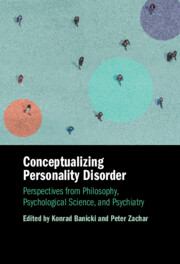 Conceptualizing Personality Disorder
Conceptualizing Personality Disorder Book contents
- Conceptualizing Personality Disorder
- Conceptualizing Personality Disorder
- Copyright page
- Contents
- Figures
- Tables
- Contributors
- Introduction
- Part I Historical Perspectives
- Part II Contemporary Approaches to Traditional Conceptual Perspectives
- Part III Novel Conceptual Approaches to Personality Disorder
- Part IV Exploring Negative Consequences of Diagnosing Personality Disorder
- Part V Perspectives on Borderline and Narcissistic Personality
- 19 How and Why Emptiness Manifests in Everyday Life
- 20 Empathy Deficits in the Development and Maintenance of Narcissistic Personality Disorder
- 21 Interaffectivity Disturbances in Narcissistic Personality Disorder
- 22 Narrative Accounts of the Self
- Index
- References
19 - How and Why Emptiness Manifests in Everyday Life
Borderline Personality Disorder and Beyond
from Part V - Perspectives on Borderline and Narcissistic Personality
Published online by Cambridge University Press: 25 June 2025
- Conceptualizing Personality Disorder
- Conceptualizing Personality Disorder
- Copyright page
- Contents
- Figures
- Tables
- Contributors
- Introduction
- Part I Historical Perspectives
- Part II Contemporary Approaches to Traditional Conceptual Perspectives
- Part III Novel Conceptual Approaches to Personality Disorder
- Part IV Exploring Negative Consequences of Diagnosing Personality Disorder
- Part V Perspectives on Borderline and Narcissistic Personality
- 19 How and Why Emptiness Manifests in Everyday Life
- 20 Empathy Deficits in the Development and Maintenance of Narcissistic Personality Disorder
- 21 Interaffectivity Disturbances in Narcissistic Personality Disorder
- 22 Narrative Accounts of the Self
- Index
- References
Summary
A significant number of people diagnosed with BPD experience emptiness. Service-users report that feelings of emptiness are intolerable, terrifying, and debilitating, and research shows that it is contributory to self-harming and suicidal behaviors including completion of suicide. Yet this criterion seems to be the least investigated of any of the nine criteria. This chapter examines what ‘emptiness’ is and whether current research reflects necessary and sufficient conditions for the concept. I describe prevailing thinking on the development of BPD and emptiness. The chapter then turns to experiences of emptiness that are found in other diagnoses, everyday life, and cross-culturally. I suggest that not all experiences of emptiness are signs of pathology. The second half of the chapter focuses on treatment possibilities, focusing on people diagnosed with BPD. I set out the main ideas in Dialectical Behavioral Therapy (DBT) and then work with one of the core methods in DBT for skill-building—mindfulness—to argue that some service-users may benefit from practicing Buddhist meditation. I conclude by discussing and responding to critics of such a position, after which I emphasize that Buddhist meditation is not for everyone and is only one option for treatment of feelings of emptiness.
Keywords
Information
- Type
- Chapter
- Information
- Conceptualizing Personality DisorderPerspectives from Philosophy, Psychological Science, and Psychiatry, pp. 335 - 351Publisher: Cambridge University PressPrint publication year: 2025